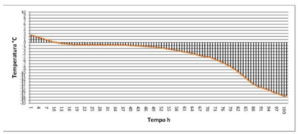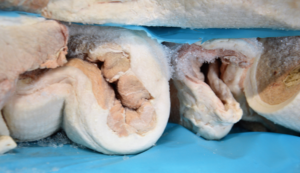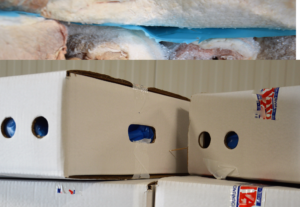The freezing of raw foodstuffs is an industrial process of considerable importance for the regulation of the market flows on the purchase of the goods. It is generally practised in the event of strong price fluctuations or when there is an elevated quantity of seasonal or production requests.
During the process, it is of utmost importance that the method used for the freezing of the product is as rapid as possible. In this way, it will be possible to conserve the original characteristics even during a storage period that is usually longer compared to that of normal refrigeration.
A recurring method that also works for all raw foodstuffs or semi-processed foods is the use of a tunnel with forced air or Blast Freezing.
It is comprised of refrigerator cells equipped with strong fans that, thanks to the low temperatures reached by the cell, subject the goods to a high flow of cold air. Thanks to conveyors that uniformly distribute the air, the freezing time is greatly reduced when compared to conventional freezing in a cell at -18°C.
THE PHASES OF FREEZING
1) COOLING
4°C / 0°C: corresponds to the time required to reach the temperature when freezing begins. It is a relatively brief period, taking about 10% of the total time used in the whole freezing cycle.
2) FREEZING
-1°C / -6°C: it is the phase in which there is a change in the state of the product, in which the water contained in its cells freezes. It is the period that has to be overcome in the shortest time possible and represents about 60% of the total time.
3) BELOW FREEZING
up to -12°C: in this phase, quicker than the previous one, it takes about 30% of the total time to reach the freezing temperature at the core, and consequently, that of conservation. The completion at -18°C takes place in the storage warehouse.

18°C.
Even during the logistic phases, it is necessary to ensure that the time is as rapid as possible, with
the goal of not interrupting the cold chain and reducing manual costs.
THE MAIN FACTORS THAT INFLUENCE THE PRENETRATION OF COLD IN THE PRODUCT
Rule for a good freezing: the less time needed for freezing the product “at the core” (that is, internally) the more the quality of the product will remain unaltered.
Packaging: in order to obtain the aforesaid result, the product should not be protected by packaging that is too thick or by layers that reduce its thermal exchange, prolonging the freezing time. The example of what has just been cited is a product packed in boxes and positioned one atop the other on pallets; this combination is not recommended for the excessive amount of time required. However, if that is the necessary procedure, there are certain rules to comply with:
– keep a distance between boxes on pallets of at least 10 cm on all sides, with the goal of allowing the air flow to freely circulate between the packaged goods.
– Use containers/boxes with side openings for the passage of air within them of at least 4% – 5% of the surface.
Mass, form and thickness of the product: the greater the size/thickness of the product, the longer it will take for it so reach the temperature that will freeze it at the core.
Thermal conductiveness:t his is an intrinsic characteristic of every product and it indicates its speed of transmission of the cold. Moreover, the more water that a product contains, the longer it will take for it to freeze.
 |
 |
If it is therefore true that an “excessive” protection is the main cause of the extension of the time, a “light” protection, or none at all, has detrimental effects, due to the excessive dehydration and consequent loss of weight of the product. This last solution however, works to the advantage of a shorter time, allowing the product to freeze according to the “rule for good freezing” previously mentioned.
It is therefore recommended to carefully establish beforehand the best product/packaging combination for a freezing cycle in a forced air tunnel, always starting from empirical tests that,
through multiple tests in different conditions, it is possible to analyse, together with the freezing curve, also the quality of the product at the end of the cycle.
| Condition | Problems | Advantages |
| Nude product, without protection of any kind | Greater dehydration
Loss of weight |
Shorter freezing times |
| Protected or packaged products | Longer freezing times | Reduced dehydration and loss of weight
Already ready for positioning in the refrigerator cell |
Do you want to always have information about our service at your fingertips? Download the pdf from HERE!
Prepared by MTC Srl – strada Pedemontana 27 – 43029 – Mamiano di Traversetolo – PARMA



